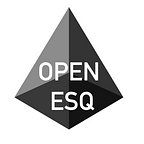Disclaimer: This isn’t legal or financial advice; only a fool would argue otherwise. Some of these platforms are still in beta, so use at your own risk.
Hello everyone. My name is Rob and today I’m going to teach you how to tokenize a product and list it on Uniswap. As a prerequisite, you’ll need a MetaMask with enough ETH to pay for gas costs. How much is enough? It depends. I spent a total of about 0.002248 ETH, which is like less than $0.50, but gas price is always fluctuating. Also, if you actually list a product on Uniswap, you’ll need enough ETH to pair the price, which is explained later.
For today’s exercise, we will be tokenizing this exquisite, limited edition Uni-Ring.
Granted it’s no Gucci, but the QR code works and it links people to my MetaMask account for payments (tips are appreciated, btw). Now, on to product details:
PRODUCT DETAILS
The Uni-Ring is 3D printed with white PLA at a setting of 0.14 mm. It’s sanded smooth with 220 grit, and has a diameter of about 22 mm. I 2D printed the QR code and “Built on ethereum” labels and just super glued them on. The QR is customizable for each customer. Rings will only be shipped within the Continental United States.
_____________________________________________
“Okay, we have the product. What now?”
My goodness you’re impatient…
Now we create an ERC20 token. Since you’re in such a hurry, I’ll use Etherscan’s ERC20 app, even though it’s still in beta. But you like to live dangerously, don’t you?
As you can see, the symbol Uni Ring trades under is URING, and the total supply is 2 with 19 zeros, but that’s because the App defaults to 18 decimals (I actually forgot about this the first go around). Really, we’re only creating 20 Uni Ring tokens. That’s right. This is a limited edition ring. How do you know I won’t make more? I’ll tell you in Part 2 of this series.
First, we make sure the _owner address is my own MetaMask address. Then we click the “Connect to Web3 link,” which gives us a warning that the app is still in beta and asks us to accept. Once accepted, we’re ready to click “Write.”
This opens up our old friend MetaMask, which calculates the gas needed. Click “Accept,” and our request is sent to the blockchain, where it will be processed. MetaMask gives us a notification, and if we click on the Fox icon and on “Contract Interaction” we see a nice review. If we click on the blue arrow angled upward, we can view the transaction on Etherscan.
From here, we can view the Uni Ring (URING) contract and see that our account is the proud owner of 20 URING tokens.
We copy the Contract address to our clipboard, then head on over to the Uniswap Exchange, and click “Swap Tokens.”
Which takes us to the main page. My MetaMask is already connected, but you might need to click “Connect” in the upper right if yours isn’t. We see the main page.
But we don’t want to swap tokens, we want to Pool them. So we click that option, then click on the “Add Liquidity” menu. From here, we select the option “Create Exchange.”
From here, we paste the contract address of URING that we copied earlier and click “Create Exchange.” Then we wait for the transaction to process.
Ta da! There’s now an exchange that allows you to trade ETH for URING. But there’s a problem. There aren’t any URING tokens on the exchange. That’s okay, we’ll add them. We once again click the menu and select “Add Liquidity.”
We click on the “Deposit” menu and see a search bar, followed by a bunch of other tokens. We paste our contract address in the search bar and see URING come up, click on it, and see that we are (of course) the first to add liquidity.
Now here’s where we have to decide price. However much ETH we add will give the equivalent price in USD to our tokens. So if we add $20 worth of ETH, our tokens will only be worth $1 each. That won’t even cover shipping! Plus, this is such a rare item. I’ll put about $460 worth of ETH for a paired price per token at $23. But I’ll actually only add 19 of the tokens, keeping one for myself, setting the paired price at $24.21. We wait for it to process and ba-ta-bing, ba-ta-boom! You can now click on “Swap,” search for and purchase URING.
But what’s that Slippage Warning?? And how do you redeem the tokens for the Uni Rings?? How do you even know I’ll follow through and not just pocket the cash without delivering?? Part 2 is where the real magic happens, where we’ll walk you through Uniswap’s brilliant method of dynamic pricing, and introduce you to creating seller liability on a mind-blowing Ethereum-based platform called “OpenLaw.”
Stayed tuned.
Shout out to the Unisocks team for being the first to Uniswap-ize products.
